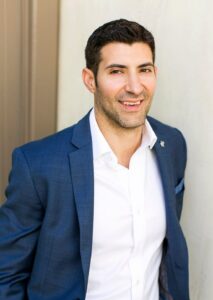An Interview With Fotis Georgiadis
Build a network and support system. Who are the mentors, advisors and partners who can help you and your team achieve your goals? It can be isolating when building and leading a company — days are packed, weekends are sacrificed, and you’ll have to make tough decisions and trade offs — but having a support system is crucial to talk things through and help manage the emotions and challenges in this journey.
As a part of our series called “Making Something From Nothing”, I had the pleasure of interviewing Christina Oriel.
Christina Oriel is the Chief Revenue Officer of BayaniPay, a cross-border financial platform for global professionals. She has nearly a decade of experience as an editor and communications consultant helping build and strategize media ecosystems, small businesses, and inclusive technology.
Thank you so much for doing this with us! Before we dive in, our readers would love to learn a bit more about you. Can you tell us a bit about your “childhood backstory”?
I was born and raised in the heart of Los Angeles by parents who migrated from the Philippines as young professionals. They’re both entrepreneurs and together, they built the Asian Journal, a multimedia publisher bringing news to the Filipino American diaspora in the United States, which celebrated its 30th year in business in 2021. Growing up, it was normal to see them work hard and come home late or there being business-related conversations at dinner. After school or during breaks, my siblings and I would have to tag along to meetings or events and be put to work, such as having to set up booths and hand out newspapers! I thought these experiences would detract me from entering the media industry, but I couldn’t stay away from chasing my curiosity, telling stories, and building community within a niche market.
Looking back now, my family’s sacrifices have given me the opportunities for higher education and have illustrated what is possible when you put in the work. Being exposed to building a business and meeting people from all walks of life at an early age have shaped my worldview and have taught me to keep an open mind. In my career so far, whether it’s in media or tech, I’ve been guided by thinking about how immigrant families like mine can be better informed and served in order to thrive in the United States.
Can you please give us your favorite “Life Lesson Quote”? Can you share how that was relevant to you in your life?
Steve Jobs once said, “Your time is limited, so don’t waste it living someone else’s life.” With social media, we often see the highlights of other people’s lives and naturally compare ourselves, which is unfair on both sides because you’re not seeing the entirety and don’t know what someone is really going through offline. Success is not linear and does not look the same for everyone. Learning this early on — sometimes the hard way — has provided more clarity and headspace in following my own path and purpose, not someone else’s definition.
Is there a particular book, podcast, or film that made a significant impact on you? Can you share a story or explain why it resonated with you so much?
How I Built This by Guy Raz! Each episode is structured with engaging storytelling that goes into the process of how companies and brands we all love came about and thought provoking questions that bring out the humanness and relatability of the personalities. Some of my favorite episodes include interviews with Melanie Perkins (Canva), Jen Rubio (Away), Sara Blakely (Spanx) and Nancy Twine (Briogeo). They are examples of women founders who have lived interesting lives before starting their own companies.
Ok super. Let’s now shift to the main part of our discussion. There is no shortage of good ideas out there. Many people have good ideas all the time. But people seem to struggle in taking a good idea and translating it into an actual business. Can you share a few ideas from your experience about how to overcome this challenge?
The BayaniPay team built the app in six months and in the midst of a pandemic! Delivering an interactive and usable service given the circumstances is no small feat. If our team surrendered and said, “Well, there are dozens of remittance companies doing what we want to do,” then BayaniPay would not be up and running today with the mission of disrupting the remittance industry.
What’s exciting about the potential of BayaniPay is that while it’s anchored on remittance as a core service — and is offering a value proposition of zero fees and market-leading exchange rates — the revenue model is diversified with forthcoming features, including digital banking (which will be offered in partnership with a large bank here in the United States), loans, e-commerce, and rewards for users. On the horizon, the key remittance players we once viewed as direct competitors will no longer be, as BayaniPay is not just another remittance company. We’re consistently monitoring the remittance and fintech industries, listening to early customers’ feedback, and making the case for why this segment (initially being global Filipino professionals) deserves to be invested in and addressed with our solutions — all of which have led us to improve upon our core offering as well as usher in the next phase of what BayaniPay can and will be.
Often when people think of a new idea, they dismiss it saying someone else must have thought of it before. How would you recommend that someone go about researching whether or not their idea has already been created?
How many times have we thought of a “brilliant” idea only to Google it and see that someone else is doing a version, or even exactly what you thought of? It can be disheartening and deter any hopes of taking that leap of entrepreneurship. However, researching what’s already on the market can be a validating point that there’s an audience and need, and in turn, it can reveal an opportunity to run with.
What are the features missing? What are the friction points that are still not being addressed? Start asking questions along those lines. Then survey individuals who represent the audience you would target and listen to their frustrations and wants, and have conversations with any mentors or advisors who can help you shape up that idea. You’ll gain more clarity and narrow down how your idea can be the differentiator. From there come the more concrete steps like creating a business plan, figuring out funding, building a team, and developing and testing until you’re ready to launch.
For the benefit of our readers, can you outline the steps one has to go through, from when they think of the idea, until it finally lands in a customer’s hands? In particular, we’d love to hear about how to file a patent, how to source a good manufacturer, and how to find a retailer to distribute it.
Have a clear business plan; assemble a team of talented people who get as excited about the idea and believe in your mission; find the strategic partners/investors who can give you the resources and insight to build; test, validate your assumptions, get feedback and refine before you’re ready to launch.
For example, BayaniPay is a digital product, but we recognize that in order to acquire and retain customers, we need to be highly visible on the ground and meet them where they are. In figuring out your target market, it’s important to be at the retailers and other places where they would be and recognizing their habits. For us, having the strategic partnership with Seafood City, the largest Filipino American grocery chain in the U.S., has helped us engage directly with customers and it helps build brand recognition and trust.
What are your “5 Things I Wish Someone Told Me When I First Started Leading My Company” and why? (Please share a story or example for each.)
- Build a network and support system. Who are the mentors, advisors and partners who can help you and your team achieve your goals? It can be isolating when building and leading a company — days are packed, weekends are sacrificed, and you’ll have to make tough decisions and trade offs — but having a support system is crucial to talk things through and help manage the emotions and challenges in this journey.
- Be agile. With my journalist/editor hat, I’ve been used to chasing deadlines and making sure a story is submitted when it needs to be. Shifting gears to a startup has meant drawing a line between being flexible while keeping everyone on track and focused because timelines are constantly fluid. With BayaniPay, we set several dates to launch Version 1.0, but they didn’t pan out due to various circumstances, from sorting out kinks in the technology to the messaging and value proposition not being clear enough. It can be frustrating when plans change, but I’m learning to be patient and that it’s okay to make mistakes, experiment, and refine based on what you’ve learned. You have to be flexible and adapt to the needs of the moment and have time work in your favor. We released early access of BayaniPay in October 2021 and racked up a solid base of early adopters before we publicly launched in November to ramp up for the holiday season, when we knew individuals would be sending remittances. The product, marketing, and overall strategy are different from the early days. It doesn’t have to be the “perfect product” because if you’re aiming for that, then you’ll never launch.
- Prioritize and delegate. In the past two months alone, BayaniPay has grown quicker than we initially anticipated and our priorities include customer acquisition, product expansion, and fundraising. Being an intuitive leader means knowing how to delegate responsibilities, especially the day-to-day tasks, and recognizing that it’s a team effort to get to the next level. It also builds trust and empowers team members to lead from where they stand and let their expertise and skills shine. And as a leader, you’ll have the room to strategize the long-term vision.
- Listen and engage with your customers. The customer service and marketing teams, as well as the brand ambassadors who represent BayaniPay at activations and events, are on the frontlines of facing customers and receiving direct feedback. While it can be validating to hear from customers about how satisfied they are with the product, not every message will be positive. It’s about balancing how we can take these responses to improve the product and customer experience while simultaneously recognizing you can’t completely change everything and cater to everyone. BayaniPay is a fintech company so we’re going after the digitally savvy customers — those who use other digital remittance/financial services but we’re offering greater value for them to switch over. While it’s a goal to take a share of the customers who remit using cash at brick and mortar outlets, we’re not using all our energy chasing them as there will still be some resistance to switching over.
- Take a breather, reflect, and don’t forget to celebrate the victories along the way. Reminding myself of this every day! Being Chief Revenue Officer means monitoring the different avenues that bring in revenue for the company and reflecting on what our team should continue or stop doing. Seeing the increase in the number of users and the volume of remittances BayaniPay processes each day is validating that the product is working and gaining traction. We make it a point to highlight these metrics during the weekly team meetings and to set benchmarks accordingly. It also boosts morale to see that our work has support and is being recognized. Again, putting it in the context of building and launching a startup with a remote team during a pandemic should be celebrated!
Let’s imagine that a reader reading this interview has an idea for a product that they would like to invent. What are the first few steps that you would recommend that they take?
Understand and specialize in your audience and target market and make sure your intentions are aligned. Particularly when working in a niche segment and being a new player, how you position, brand, and market your product are crucial in cutting through the noise and standing out. Consumers are discerning enough to know when an idea or product are not genuine. They want to be spoken to and not be spoken at.
There are many invention development consultants. Would you recommend that a person with a new idea hire such a consultant, or should they try to strike out on their own?
It depends on if you want to spend this early on in the ideation stage. My recommendation would be to see who you can start introductory conversations with in your network — you can look at LinkedIn or other social media and reach out. It never hurts to start networking and getting feedback to further hone in on your mission. You never know, it could lead to more connections and opportunities to advance your idea.
What are your thoughts about bootstrapping vs looking for venture capital? What is the best way to decide if you should do either one?
I’m learning a lot about how to pitch and fundraise as in my previous experiences, I’ve had to figure out how to make an impact without an abundance of resources. I’m grateful to have BayaniPay’s CEO Winston Damarillo as a mentor and to be on this ride with him. He’s a serial entrepreneur with three successful Silicon Valley exits so fundraising is not new for him and his approach to seeking investors has allowed BayaniPay to grow and expand faster in the first year. One option isn’t better than the other. As an entrepreneur, this question would depend on what your goals are, how quickly you want to grow and if outside funding can help you achieve that, and ultimately how much control and equity of your business you want to give up.
Ok. We are nearly done. Here are our final questions. How have you used your success to make the world a better place?
Success should not be for one person or only for an exclusive group of people. I’ve strived to uplift others and bring them along too for various projects. If an opportunity comes my way and it’s not a right fit or I don’t have the capacity, who in my ecosystem can I tap and recommend? It could be life-changing for them.
You are an inspiration to a great many people. If you could inspire a movement that would bring the most amount of good to the most amount of people, what would that be? You never know what your idea can trigger.
A movement that empowers people to make braver choices and to embrace who they are. Too often, many women — and women of color, in particular — get stuck in imposter syndrome and that they aren’t competent enough to take the risk or put themselves out there. Taking out the barriers of negative self-talk and limiting beliefs and allowing room for mistakes and learning from them will only make society and the world a better place because people can realize their potential.
We are very blessed that some of the biggest names in Business, VC funding, Sports, and Entertainment read this column. Is there a person in the world, or in the US, with whom you would love to have a private breakfast or lunch, and why? He or she might just see this if we tag them.
Great, but tough question! I’m fortunate to be living in a time when there are many women founders globally to look up to. I would choose Emily Weiss, the founder and CEO of Glossier, one of my favorite beauty brands. I’ve followed her since she began Into the Gloss, a beauty website that ultimately led to the birth of Glossier based on what readers wanted in products. During our lunch, I’d share the similarities in our journey in how we’ve used writing and audience feedback to give insight on what services and products should be on the market and how technology can help deliver them.
Thank you for these fantastic insights. We greatly appreciate the time you spent on this.
Making Something From Nothing: Christina Oriel Of BayaniPay On How To Go From Idea To Launch was originally published in Authority Magazine on Medium, where people are continuing the conversation by highlighting and responding to this story.



